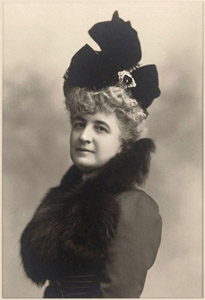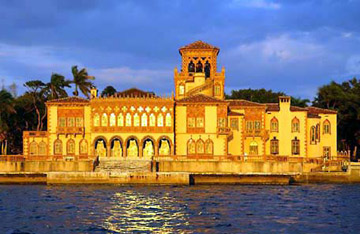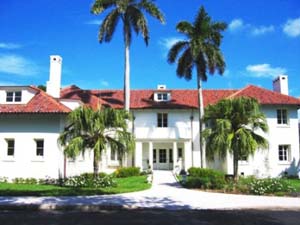Sarasota’s Rich History Pt.2
Prestigious Past Defines Community
While the beginnings of the region were humble, by the early 1900s Sarasota welcomed a steady flow of prestigious residents who made a mark on the development of Sarasota as a city and cultural center, and left a legacy of historic sites that continue to impress locals and visitors alike. These wealthy entrepreneurs helped define the personality of the region and usher in an era of wealth and prosperity that continues to this day.
Among the early settlers was John Hamilton Gillespie, a Scottish lawyer and aristocrat who is credited with building the first golf course in America. When the village of Sarasota became a town under state guidelines in 1902, Gillespie was named the first mayor. He also built the DeSoto Hotel on Main Street, which attracted both tourists and prospective investors. Progress such as this paved the way for other land developers and millionaires, who began mapping out their own business legacies in ranching, farming, and city planning.

Among the first was Bertha Honoré Palmer, an early 20th Century socialite and the widow of multimillion dollar estate developer Potter Palmer, whom she married in 1871. Her association with Florida began in 1910, eight years after his death, when she purchased more than 80,000 acres including Manatee County. She added an additional 19,000 acres in 1914 to create “River Hills Ranch” hunting preserve, which now is Temple Terrace, Fla., near Tampa. Most notably, Palmer also bought a large tract of land that was turned into Myakka River State Park following her death in 1918. The river itself traverses 58 square miles of wetlands, prairies, hammocks, and woodlands, and from 1934 to 1941, the park was developed by the Civilian Conservation Corps with assistance from the National Park Service and Florida Park Service, according to the Florida Online Park Guide. Today, it is one of Florida’s oldest and biggest parks, consisting of 37,000 acres. While Palmer owned the property it was a functioning 30,000-acre cattle ranch called Meadowsweet Pastures, which is well known today for helping to revolutionize large-scale ranching practices within the state.
In addition to becoming the top land owner in and around Sarasota in the early 1900s, Palmer was one of the first aristocrats to promote the city as a winter haven for the rich and famous, especially as an alternate to foreign destinations at the onset of World War I. She established her own enclave just north of Spanish Point, the homestead founded by the Webb family, and this home base helped establish Sarasota as one of the most fashionable Florida vacation destinations. According to the Sarasota History Alive, she acquired Lawrence Jones’ two-story house called The Oaks on Little Sarasota Bay, and hired the Chicago architect Thomas Reed Martin, who moved to Sarasota, to add rooms and columns to the property and create formal gardens, walkways, and ponds.
Palmer’s sons Honoré and Potter carried on the family legacy by continuing to acquire and develop land parcels. In 1922, the brothers planted what was then known as the Hyde Park Citrus Groves, which eventually covered more than 1,200 acres. Today, the area is South Gate in Sarasota. In 1923, they helped to form the Sarasota-Fruitville drainage district, 8,000-plus acres that were opened up for cultivation. The land was designated as the Palmer Farms and Experimental Station and was created by removing water from a large, historic slough and dredging a straight drainage canal through the bed of Phillippi Creek. This dried out approximately 26,000 acres, and in total more than 40 square miles and 50 linear miles of canals were included in the project, which cost $750,000, according to the Sarasota History Alive.
Today, Bertha Palmer’s influence still is visible in the Palmer Ranch community, which is set on 10,000 acres of the original land purchase. Today it is the largest master planned community in Sarasota with more than 20 subdivisions. Additionally, many of the roads and thoroughfares in Sarasota’s existing communities still carry her designations, such as Honoré, Lockwood Ridge, Tuttle, Webber, and McIntosh.
While Palmer was busy undertaking ranching and farming endeavors, Owen Burns, who moved to Sarasota prior to her, became the largest landowner within the city limits. He also had many other ventures including banking; constructing bridges, landmark buildings, and mansions; and establishing Burns Court, a downtown district designed to attract commercial businesses and tourists. Additionally, in 1925 he built the El Vernona Hotel, which he named after his wife. He later was forced to sell the hotel to his former partner John Ringling at a fraction of its value following a land boom crash that ravaged his finances. Ironically, Burn’s financial demise was due in part to Ringling’s failure to uphold development agreements for the barrier islands.

In addition to being Burn’s partner, John Ringling is Sarasota’s most well known patron of the arts. His impact on the development of cultural landmarks and his high profile as a circus magnate also helped put Sarasota in the publicity limelight, which contributed to building the city’s prestigious reputation as a refined cultural living center and landed it the moniker “Florida’s Cultural Coast.” In 1927, he moved the winter headquarters of the Ringling Brothers and Barnum & Bailey Circus to Sarasota, where he and his wife Mable had been spending the season since 1909. In 1926, they completed a 30-room Venetian Gothic mansion named Cà d’Zan (House of John) that was designed by New York architect Dwight James Baum. The couple also built the John & Mable Ringling Museum of Art, which houses an extraordinary collection of work by Peter Paul Rubens and other 17th Century Italian and Flemish masters. The museum, which was designed by the architect John H. Phillips in 1927, officially opened in October 1931.
Ringling also was an entrepreneur and aggressive businessman who had grand plans for Sarasota’s outlying islands. He formed Ringling Isles Estates with Burns, who also was responsible for building the John Ringling Bridge and using the dredge to create Bird Key, an island between St. Armands Key and the mainland that is now an oasis of posh residences. Ringling purchased St. Armands Key in 1923 as an uninhabited 150-acre island. Burns developed the community, and well-known landscape architect John J. Watson designed the layout, which included a central circle park named for President Warren Harding (St. Armands Circle), boulevards, and medians. The community officially opened in 1928 when the bridge to the mainland was completed. According to Sarasota History Alive, Harding Circle was placed on the National Register of Historic Places in January of 2001 for its unique approach to community planning and land development.
Despite the great strides made in developing St. Armands Key, both businessmen were greatly impacted by financial difficulties that spread through Florida leading up to the Great Depression. Just prior to the stock market crash, Ringling invested in new circus ventures that were not profitable, and in the wake he was forced to abandon many projects, including an exclusive hotel on one of the barrier islands. At the time of his death in 1936, Ringling was almost bankrupt and he willed most of his estate and art collection to the state.
John’s brother Charles Ringling also was instrumental in the evolution of Sarasota. A land developer and bank founder, he built the Sarasota Terrace Hotel downtown in the Chicago style of architecture and donated adjacent land for the county seat. Ringling Boulevard was named in his honor, and the street crosses Washington Boulevard at the location of the hotel. Additionally, he and his wife Edith built a bay front residence that was completed just before his death in 1926. The home, which became known as The Edith Ringling Estate, is now at the center of the New College of Florida campus.
Significant Sites Dot Landscape
Currently, there are more than 60 historically significant sites designated in Sarasota, which are listed online at Sarasota History Alive. These unique commercial and residential buildings are ever-present reminders of Sarasota’s far-reaching architectural heritage. In addition to Ringling’s Cà dˈZan, among the notable estates are the houses at Marie Selby Botanical Gardens and the Marie and William (Bill) Selby purchased seven acres of land adjoining Sarasota Bay and Hudson Bayou in the early 1920s and built a two-story Spanish style home among the lush banyan trees on the property. Bill was a partner with his father in the Selby Oil and Gas Company and Marie was an accomplished musician. They both shared a love of the outdoors Marie was an avid gardener who designed the property’s landscaping and prominent rose garden. Marie passed away in 1971 and willed the property to the community as a botanical garden, which was opened to the public in 1975. Since that time the property has grown from seven acres to nearly 13 acres, and there are more than 20,000 plants on display in eight greenhouses.

The Italian Renaissance style Edson Keith Mansion was designed by the Chicago-based architectural firm of Otis and Clark for Edson and Nettie Keener Keith, who were members of the “Chicago Colony,” wealthy Midwesterners who spent at least part of the year in southwest Florida. The couple purchased 60 acres on the shores of Phillippe Creek in 1916 and moved from Chicago to live in Sarasota year-round. The home later was sold to another Chicagoan, Mae Hansen Prodie, who is known for creating the Barbie doll wardrobe concept. Her husband Charlie Prodie, a retired executive of Walgreen’s, ran the estate as a restaurant and inn. After Mae’s death in 1986, Sarasota County purchased the estate for $5.2 million and refurbished it for public use.
Architectural gems such as this dot the landscape of Sarasota and have made the city glimmer over the years. And the magnificent homes of the early 20th Century now stand stately among more recent buildings that have helped to grow the local real estate inventory and provide a wide variety of luxury housing options. The northern shore of the Sarasota Bay is a perfect example, as many of the historic residences built there during the 1920s boom have survived. The area originally was platted in 1895 as Shell Beach by Mary Louise and Charles N. Thompson, who later sold a large portion of the land to John and Mable Ringling for their winter retreat. The same type of juxtaposition can be found in the historic Indian Beach Sapphire Shores neighborhood that grew immediately to the south. This community, which contained a spattering of pioneer homes, became a hub for accomplished businessmen and others who wished to associate with the wealthiest upper crust of Sarasota in the 1920s.
These old-world inspired properties now are interspersed with even more recent designs, such as those of the Sarasota School of Architecture. Although many of these structures were lost over the past few decades because they did not qualify for historic preservation, there still are some excellent examples of this style, which combines characteristics of Bauhaus and the concepts of Frank Lloyd Wright. Paul Rudolph was a prominent Sarasota figure in this post-war architectural movement, which also is know by the name Sarasota Modern. One of the best examples left is Rudolph’s Umbrella House in Lido Shores, which once was an exclusive subdivision designed entirely in the Sarasota School of Architecture style.
As you can see from this small snapshot of Sarasota’s community history, there is a fantastic foundation of great developers, land owners, and architects behind the modern-day masterpiece that this city has become. Whether you chose to reside in a downtown high-rise, a master planned golf community, or a beach estate on one of the Keys, calling Sarasota home allows you to weave your own thread in this wonderful tapestry of culture and resort lifestyle living.
Contact Christina Miller
You can contact me by either:
Phone: 941-713-2340
Skype: "sarasotabay"
By Email:
Christina Miller
Sarasota Bay Real Estate
2033 Main Street Suite 104
Sarasota, Florida
34237
- Christina Miller, Broker and Owner of Sarasota Bay Real Estate, 2033 Main Street Suite 104, Sarasota Florida, 34237 - Direct line: (941) 713-2340
